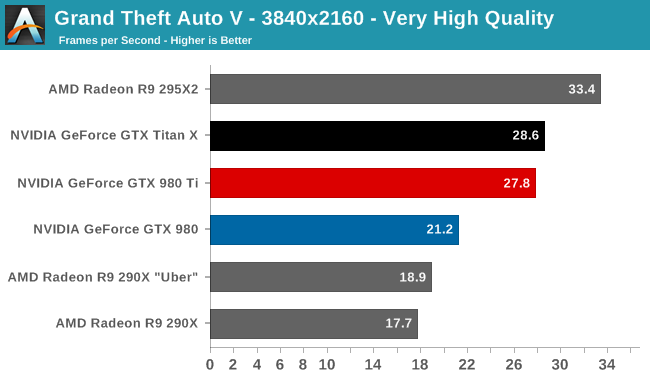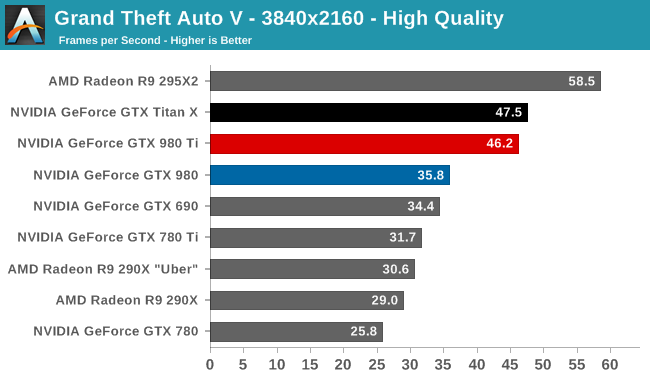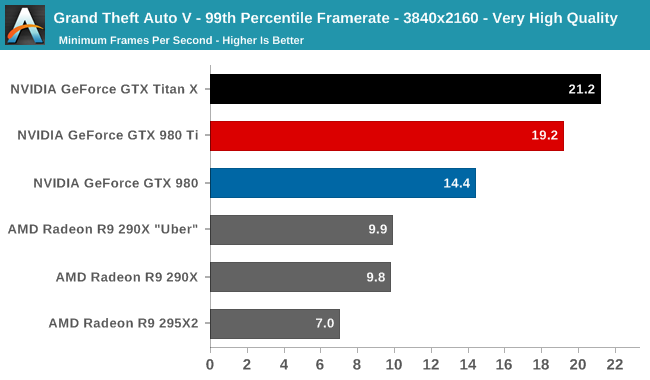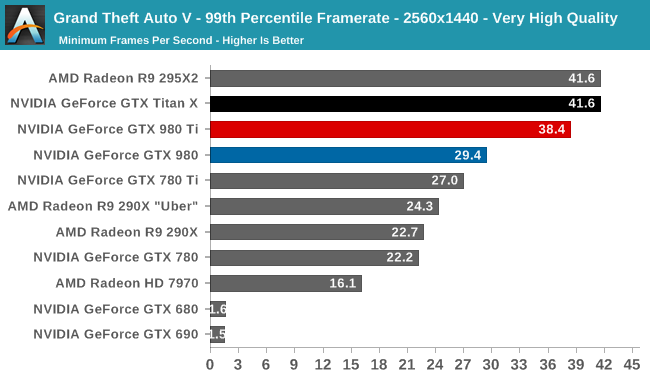The NVIDIA GeForce GTX 980 Ti Review
by Ryan Smith on May 31, 2015 6:00 PM ESTGrand Theft Auto V
The final game in our review of the GTX 980 Ti is our most recent addition, Grand Theft Auto V. The latest edition of Rockstar’s venerable series of open world action games, Grand Theft Auto V was originally released to the last-gen consoles back in 2013. However thanks to a rather significant facelift for the current-gen consoles and PCs, along with the ability to greatly turn up rendering distances and add other features like MSAA and more realistic shadows, the end result is a game that is still among the most stressful of our benchmarks when all of its features are turned up. Furthermore, in a move rather uncharacteristic of most open world action games, Grand Theft Auto also includes a very comprehensive benchmark mode, giving us a great chance to look into the performance of an open world action game.
On a quick note about settings, as Grand Theft Auto V doesn't have pre-defined settings tiers, I want to quickly note what settings we're using. For "Very High" quality we have all of the primary graphics settings turned up to their highest setting, with the exception of grass, which is at its own very high setting. Meanwhile 4x MSAA is enabled for direct views and reflections. This setting also involves turning on some of the advanced redering features - the game's long shadows, high resolution shadows, and high definition flight streaming - but it not increasing the view distance any further.
Otherwise for "High" quality we take the same basic settings but turn off all MSAA, which significantly reduces the GPU rendering and VRAM requirements.



After initially expecting Grand Theft Auto to be a walk in the park performance wise, the PC version of the game has instead turned out to be a very demanding games for our GPUs. Even at 1440p we can’t have very high quality with MSAA and still crack 60fps, though we can get very close.
Ultimately GTA doesn’t do any better than any other game in setting apart our GM200 cards. GTX 980 Ti trails GTX Titan by 4% or less, essentially the average outcome at this point. Also average is the GTX 980 Ti’s lead over the GTX 980, with the newest card beating the older GTX 980 by 29-31% across our three settings. Finally, against the GTX 780 the GTX 980 Ti has another strong showing, with a 69-79% lead.
On an absolute basis we can see that at 4K we can’t have 4x MSAA and even crack 30fps on a single-GPU card, with GTX 980 Ti topping out at 27.8 fps. Taking out MSAA brings us up to 46.2fps, which is still well off 60fps, but also well over the 30fps cap that this game was originally designed against on the last-generation consoles.



Along with an all-around solid benchmark scene, the other interesting benchmarking feature of GTA is that it also generates frame percentiles on its own, allowing us to see the percentiles without going back and recording the game with FRAPS. Taking a look at the 99th percentile in this case, what we find is that at each setting GTA crushes some group of cards due to a lack of VRAM.
At 4K very high quality, 4GB cards have just enough VRAM to stay alive, with the multi-GPU R9 295X2 getting crushed due to the additional VRAM requirements of AFR pushing it over the edge. Not plotted here are the 3GB cards, which saw their framerates plummet to the low single-digits, essentially struggling to complete this benchmark. Meanwhile 1440p at high quality crushes our 2GB cards, with less VRAM than a Radeon HD 7970 falling off of the cliff.
As for what this means for the GTX 980 Ti, the situation finds the GTX 980 Ti trailing the GTX Titan X in 99th percentile framerates by anywhere between 3% and 10%. This test is not designed to push more than 6GB of VRAM, so I’m not entirely convinced this isn’t a wider than normal variance (especially at the low framerates for 4K), though the significant and rapid asset streaming this benchmark requires may be taking its toll on the GTX 980 Ti, which has less VRAM for additional caching.










290 Comments
View All Comments
Daroller - Monday, June 1, 2015 - link
HAHAHAHAHA website lagged out and triple posted. That's awesome. Go go Google Chrome!naxeem - Monday, June 1, 2015 - link
I don't think it is all good with the overclocking part. On stock air (albeit 80% fan speed unless used Accelero IV at 40%) cooler TitanX cards easily get to 1300/1440 normal/boost clocks. Same cards on water got to 1375/1500 with cool-ish 55°C at max load. That applies to two TitanX in SLI with modified BIOS that allows for more power consumption and thus removes artificial limit.Since the chip is identical and 980Ti is actually partially defective TitanX with 50% less RAM and switched off defective parts, I highly doubt clock potential differs, especially not in favor of 980Ti.
I would and do expect 980Ti to clock the same as Titan X (loosing some on chip quality, gaining some on half the VRAM).
FlushedBubblyJock - Saturday, June 13, 2015 - link
Nope. Other test sites show the opposite - 980TI is an overclock monster and beats the TXtruongpham - Monday, June 1, 2015 - link
Ryan, can you bench this one with Windows 10 and DX12?Ryan Smith - Monday, June 1, 2015 - link
We won't be doing any complete Win10 benchmarking until that OS is finished and released. As for DX12, there are no games out yet that re using it; the handful of benchmarks are focused tech demos.cknobman - Monday, June 1, 2015 - link
Nvidia must have seen some undisclosed AMD benchmarks, went into panic mode, and rushed a release for the 980TI to get customers before the AMD launch.While its a great card the problem is Nvidia screwed some of their own customers.
I take this as a sign that whatever AMD is coming out with must be pretty good. :)
galta - Monday, June 1, 2015 - link
Maybe, but it could prove to be of little importance.You see, Win10 will be out on June 29th. Realistically speaking, DX12 games won't be real before Christmas or 2016.
It is more than enough time for a possible counterstrike from nVidia.
Having said that, unless one really really needs to upgrade now I would strongly recommend waiting for another month, just to check what Fiji is up to.
As of me, I have a pair of 980GTX Strix and have been with nVidia for a while, but I really hope AMD gets this one right.
Real competition is always good.
JayFiveAlive - Monday, June 1, 2015 - link
I've been waiting for this beast to drop... now to decide whether it's a good time to bite.Current setup is a 2500K OC to 4.4Ghz and a GTX 670, so kinda oldish... Was considering upgrading to a Skylake proc come Sept and this 980 Ti, but probably Gigabyte variant... hmmm.
Peichen - Tuesday, June 2, 2015 - link
Why upgrade CPU? 2500K at 4.4GHz is still very fast and shouldn't affect performance of a 980Ti much. Maybe 10% less fps vs if you have a 6-core Extreme but why spend $300-400 to get 10% improvement?mapesdhs - Wednesday, June 3, 2015 - link
Plus if he does need some more CPU oomph, just put in a 2700K. I've built six so far, every one of them happily runs at 5GHz with just a decent air cooler & one fan for quiet operation, though for final setups I use an H80 and two quiet fans. Some games will benefit from more than 4 cores, depends on the game (eg. PvP online FPS can involve a lot of host side scripting, eg. Project Reality, and the upcoming Squad).True though, 2500K is still very potent, just built a 4.8 setup for a friend. She lives on an island, it'll probably be the quickest system for miles around. :D